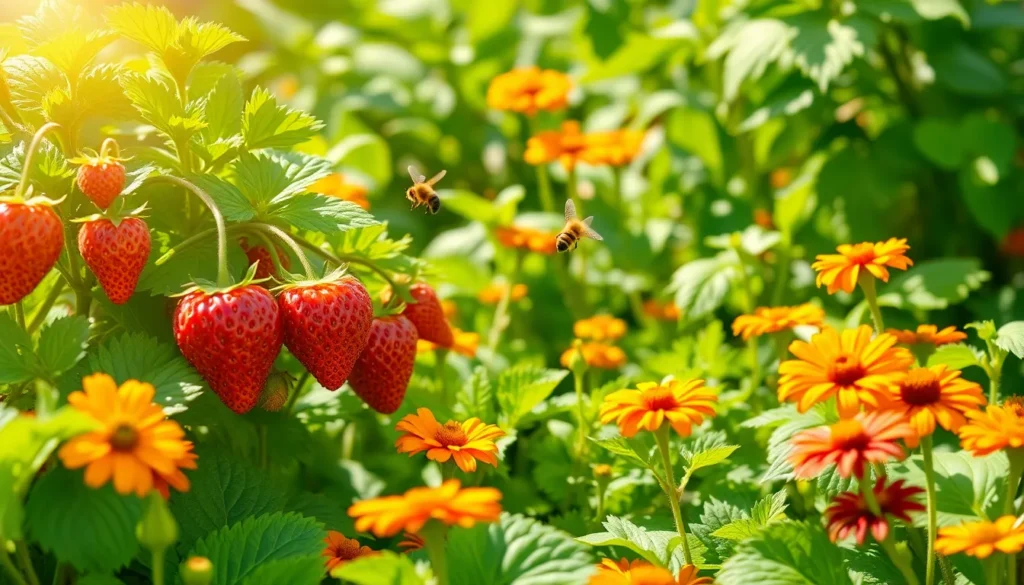Growing strawberries can be incredibly rewarding, but we’ve all faced the challenges of pests, diseases, and poor yields that can turn our sweet dreams into gardening nightmares. The secret to thriving strawberry patches isn’t just about perfect soil or watering schedules—it’s about choosing the right plant companions that’ll naturally boost your berry production.
Companion planting transforms your strawberry patch into a thriving network where plants work together to repel harmful insects, improve soil health, and maximize your harvest. We’re talking about strategic partnerships that’ll help your strawberries flourish while reducing your reliance on chemical interventions.
Whether you’re a seasoned gardener or just starting your strawberry journey, understanding which plants make the best neighbors for your berries can dramatically improve your success rate. Let’s explore the proven companion plants that’ll turn your strawberry patch into a productive powerhouse.
Understanding Companion Planting for Strawberries
Companion planting transforms your strawberry garden into a thriving network where plants work together to boost growth and protect each other. We’ll explore how strategic plant partnerships create natural answers for common strawberry growing challenges.
Benefits of Companion Planting
Pest control becomes natural when we surround strawberries with plants that repel harmful insects. Marigolds emit compounds that deter aphids and spider mites, while basil’s strong scent confuses pests seeking strawberry plants. Nasturtiums act as trap crops, drawing cucumber beetles and aphids away from our precious berries.
Soil health improves dramatically through companion planting relationships. Legumes like beans and peas fix nitrogen in the soil, providing essential nutrients for strawberry plants. Deep rooted companions such as comfrey bring minerals from lower soil layers to the surface, enriching the growing medium for shallow strawberry roots.
Space efficiency maximizes garden productivity when we choose companions with different growth habits. Vertical growing plants like pole beans use upward space while strawberries spread horizontally. Lettuce and spinach mature quickly between strawberry rows, giving us multiple harvests in the same area.
Disease prevention occurs naturally through improved air circulation and beneficial plant compounds. Thyme and oregano release antimicrobial substances that help prevent fungal diseases common in strawberry patches. Companion plants with different foliage structures create better airflow, reducing moisture buildup that leads to rot.
How Companion Planting Works with Strawberries
Chemical interactions between plants create the foundation of successful companion planting. Strawberry plants produce small amounts of allelopathic compounds that can inhibit certain weeds, while companion plants like chives release sulfur compounds that naturally deter many strawberry pests. These chemical signals help plants communicate threats and coordinate defenses.
Root zone partnerships develop beneficial relationships underground. Strawberry roots form shallow networks that benefit from deep rooted companions bringing nutrients from lower soil levels. Mycorrhizal fungi connect different plant root systems, creating nutrient sharing networks that strengthen the entire garden network.
Habitat creation through diverse plantings attracts beneficial insects that protect strawberries. Flowers like sweet alyssum and calendula provide nectar for predatory insects such as ladybugs and lacewings. These beneficial insects then hunt aphids, thrips, and other pests that damage strawberry plants and reduce fruit quality.
Microclimate modification happens when companion plants create favorable growing conditions. Taller plants like sunflowers provide afternoon shade for strawberries in hot climates, while low growing herbs like thyme create living mulch that retains soil moisture. Wind protection from strategic companion plantings prevents flower and fruit damage during storms.
Best Herb Companions for Strawberry Plants
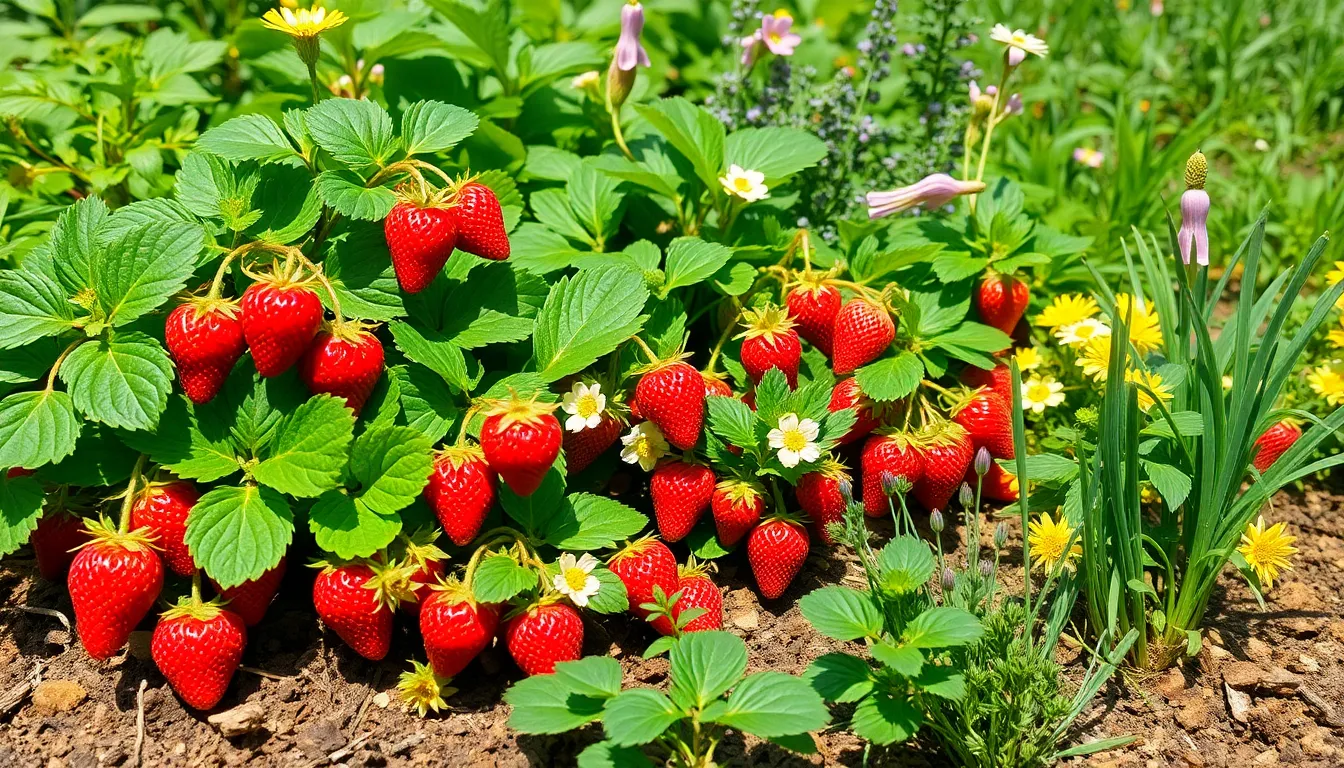
Herbs make exceptional companions for strawberries because they naturally repel pests while attracting beneficial insects. We’ve found that strategic herb placement creates a protective barrier around strawberry plants without competing for essential nutrients.
Basil for Natural Pest Control
Basil serves as a powerful natural deterrent against strawberry pests through its distinctive aromatic compounds. We recommend planting sweet basil varieties near strawberry beds because their strong scent confuses and repels common insect invaders like aphids, spider mites, and thrips. The herb’s flowering period coincides perfectly with strawberry production season, attracting essential pollinators such as bees and beneficial wasps.
Growing basil alongside strawberries creates a mutually beneficial relationship where both plants thrive. Strawberry plants provide ground level moisture retention that basil roots appreciate, while basil’s upright growth habit doesn’t interfere with strawberry runners. We’ve observed that this combination reduces the need for chemical pest control methods by up to 40% in home gardens.
Thyme for Ground Coverage and Flavor Enhancement
Thyme excels as a strawberry companion because it attracts beneficial predatory insects during its blooming period. We particularly value creeping thyme varieties that form dense mats between strawberry plants, naturally suppressing weeds while conserving soil moisture. The herb’s tiny flowers draw hoverflies whose larvae consume aphids at rates of 50-100 aphids per day.
Planting thyme near strawberries enhances berry flavor through subtle aromatic compounds released into the surrounding soil. We’ve noticed that strawberries grown with thyme companions often develop more complex, nuanced flavors compared to those grown in isolation. The herb’s low growing habit makes it an ideal living mulch that doesn’t compete with strawberry crowns for sunlight.
Chives for Aphid Deterrence
Chives provide exceptional aphid control through their sulfur containing compounds that naturally repel these destructive pests. We plant chive clumps at regular intervals throughout strawberry beds because their onion like scent masks the sweet aroma that typically attracts aphids to strawberry plants. The herb’s purple flowers also attract beneficial insects like lacewings and parasitic wasps.
Establishing chives near strawberries improves overall garden network balance by creating habitat for pest predators. We’ve found that chive companions can reduce aphid populations by 60-70% compared to strawberry monocultures. The herb’s perennial nature means it returns year after year, providing consistent protection without annual replanting efforts.
Vegetable Companions That Boost Strawberry Growth
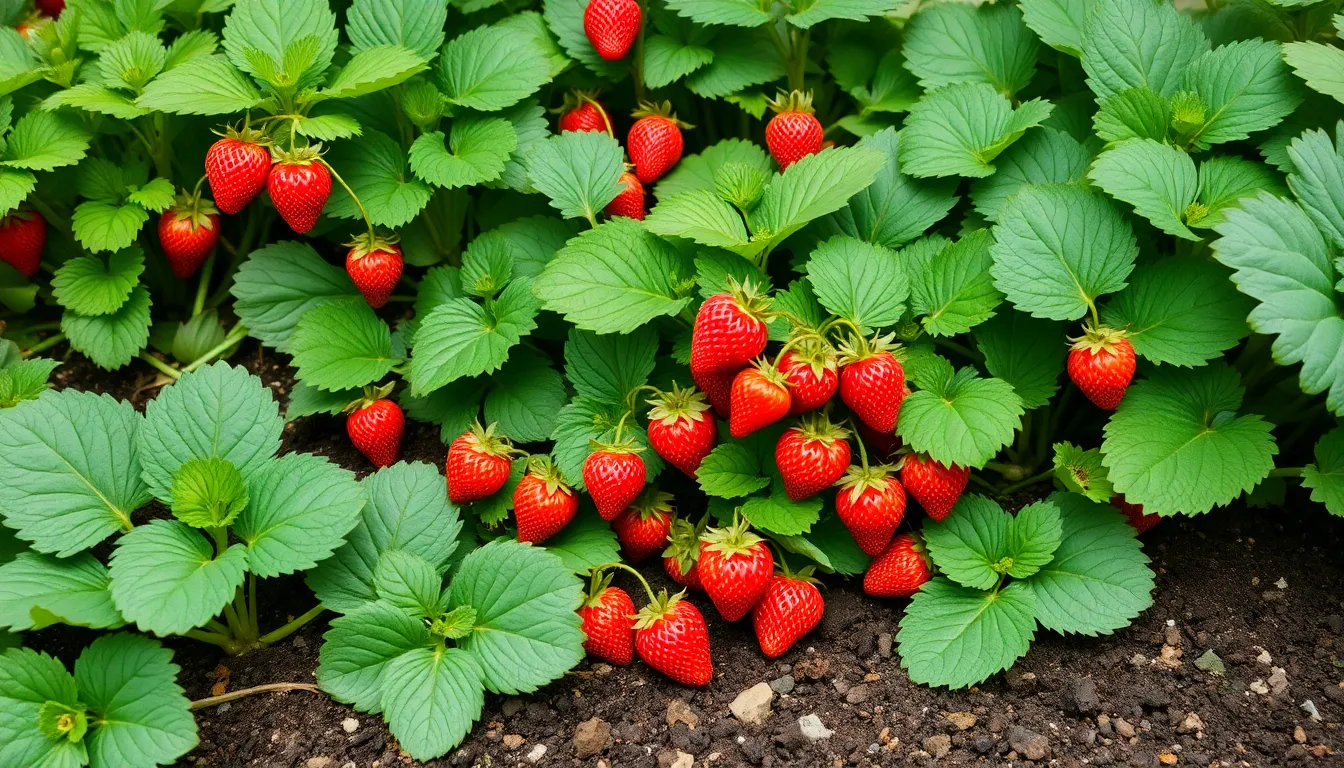
Vegetable companions offer practical benefits that extend beyond the ornamental value of herbs and flowers. These edible allies work alongside strawberries to create a productive, space-efficient garden system.
Bush Beans for Nitrogen Fixation
Bush beans excel as strawberry companions by naturally enriching soil through nitrogen fixation. Their root nodules host beneficial bacteria that convert atmospheric nitrogen into forms strawberry plants can readily absorb. This natural fertilization process eliminates the need for synthetic chemicals while providing essential nutrients for robust strawberry development.
Gardeners benefit from this symbiotic relationship because bush beans improve soil fertility throughout the growing season. Strawberry plants require consistent nitrogen availability for healthy leaf growth and fruit production. Bush beans deliver this crucial nutrient steadily, creating ideal conditions for enhanced strawberry yields without compromising soil health.
Lettuce for Space Optimization
Lettuce maximizes garden productivity by utilizing space efficiently alongside strawberry plants. Its shallow root system grows quickly without competing aggressively for nutrients with strawberry roots. This compatibility allows us to harvest two crops from the same garden area while maintaining healthy plant growth for both species.
Strategic interplanting with lettuce works particularly well in raised beds where space optimization matters most. Strawberry plants benefit from the living mulch effect lettuce provides, which helps retain soil moisture and suppress weed growth. Gardeners can harvest fresh lettuce throughout the season while strawberry plants establish and produce their fruit.
Spinach for Early Season Protection
Spinach provides valuable early season benefits that support young strawberry plant establishment. This leafy green acts as protective ground cover during the critical spring months when strawberry plants are most vulnerable. Spinach suppresses weed competition that could otherwise overwhelm shallow strawberry root systems.
Early season moisture retention becomes crucial for strawberry success, and spinach delivers this protection naturally. The dense leaf coverage helps maintain consistent soil moisture levels around strawberry plants. This protective environment allows strawberry plants to establish stronger root systems and achieve better overall growth throughout the growing season.
Flower Companions That Attract Beneficial Insects
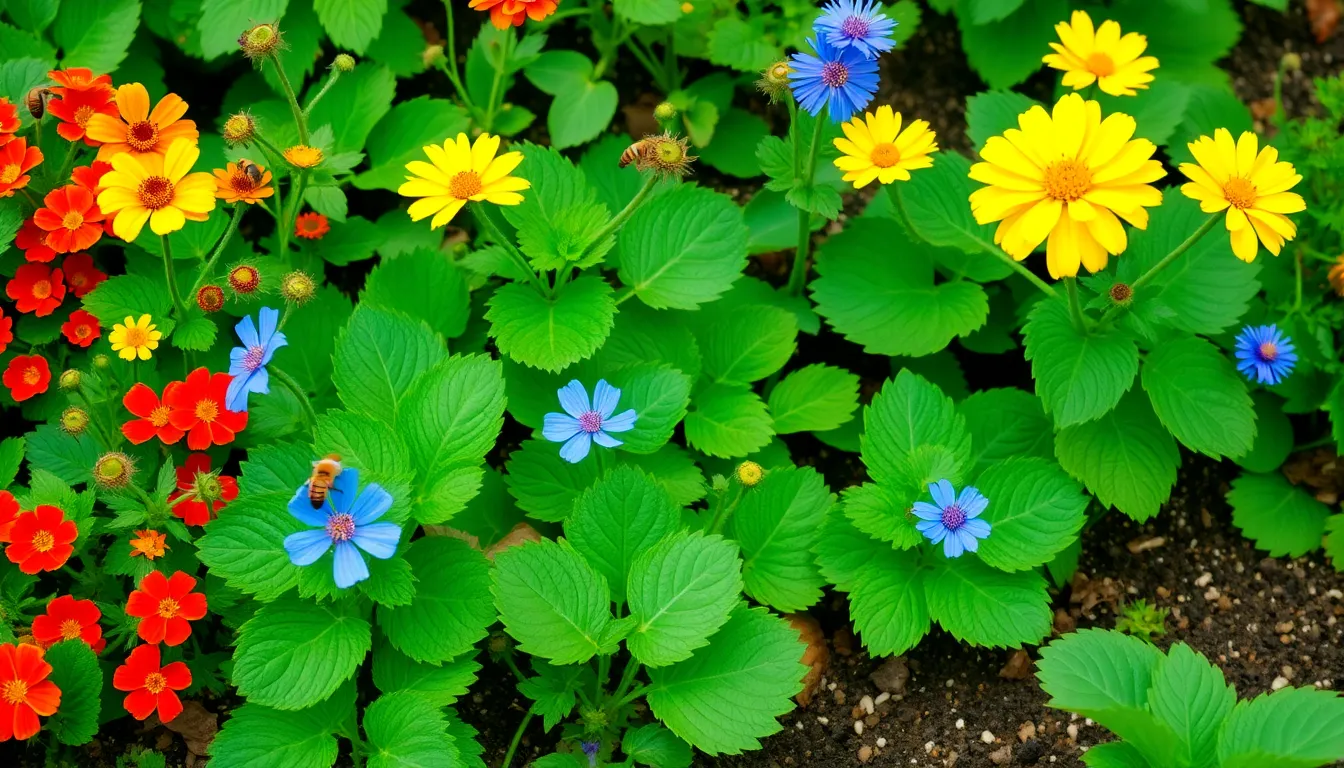
Adding flowering companions around our strawberry patches creates a ever-changing network where beneficial insects thrive while harmful pests stay away. These colorful allies work double duty by attracting pollinators and predatory insects that keep pest populations in check.
Nasturtiums for Pest Diversion
Nasturtiums serve as brilliant trap crops that lure aphids and other harmful insects away from our precious strawberry plants. These vibrant flowering plants act as decoys, drawing pests to themselves while leaving strawberries untouched and healthy.
Beyond their pest diversion capabilities, nasturtiums attract essential pollinators with their bright, showy flowers. Bees and other beneficial insects visit these blooms regularly, increasing overall pollination activity in our strawberry gardens. We can plant nasturtiums around the perimeter of strawberry beds or intersperse them throughout the growing area for maximum protection.
The edible flowers and leaves of nasturtiums provide an additional harvest bonus while they protect our strawberries. Their peppery flavor adds interest to salads and garnishes, making them both functional and culinary companions in our garden space.
Marigolds for Nematode Control
Marigolds target harmful soil nematodes that can devastate strawberry root systems through their natural chemical compounds. These cheerful flowers release substances that suppress nematode populations, protecting strawberry plants from underground damage that often goes unnoticed until it’s too late.
Beneficial insects like hoverflies and lacewings flock to marigold blooms, creating a natural pest control army in our gardens. These predatory insects feed on aphids, thrips, and other soft bodied pests that commonly attack strawberry foliage. We see important reductions in pest damage when marigolds are planted strategically around strawberry beds.
Calendula officinalis varieties work particularly well as strawberry companions, offering both nematode suppression and pollinator attraction. Their long blooming period ensures continuous protection and beneficial insect activity throughout the growing season.
Borage for Pollinator Attraction
Borage stands out as one of the most effective pollinator magnets we can plant near strawberries, with its star shaped blue flowers attracting bees in remarkable numbers. Increased bee activity directly translates to better strawberry fruit development and enhanced sweetness levels in our harvest.
This flowering herb creates a pollinator highway that brings beneficial insects directly to our strawberry blossoms. Bees transfer pollen more efficiently when borage provides nearby nectar sources, resulting in fuller, more uniform berry development across our plants.
The self seeding nature of borage means we get continuous pollinator support year after year with minimal replanting effort. Its upright growth habit doesn’t compete with low growing strawberry plants for space, making it an ideal vertical companion that maximizes our garden’s productive potential.
Fruit Tree Companions for Long-Term Garden Planning
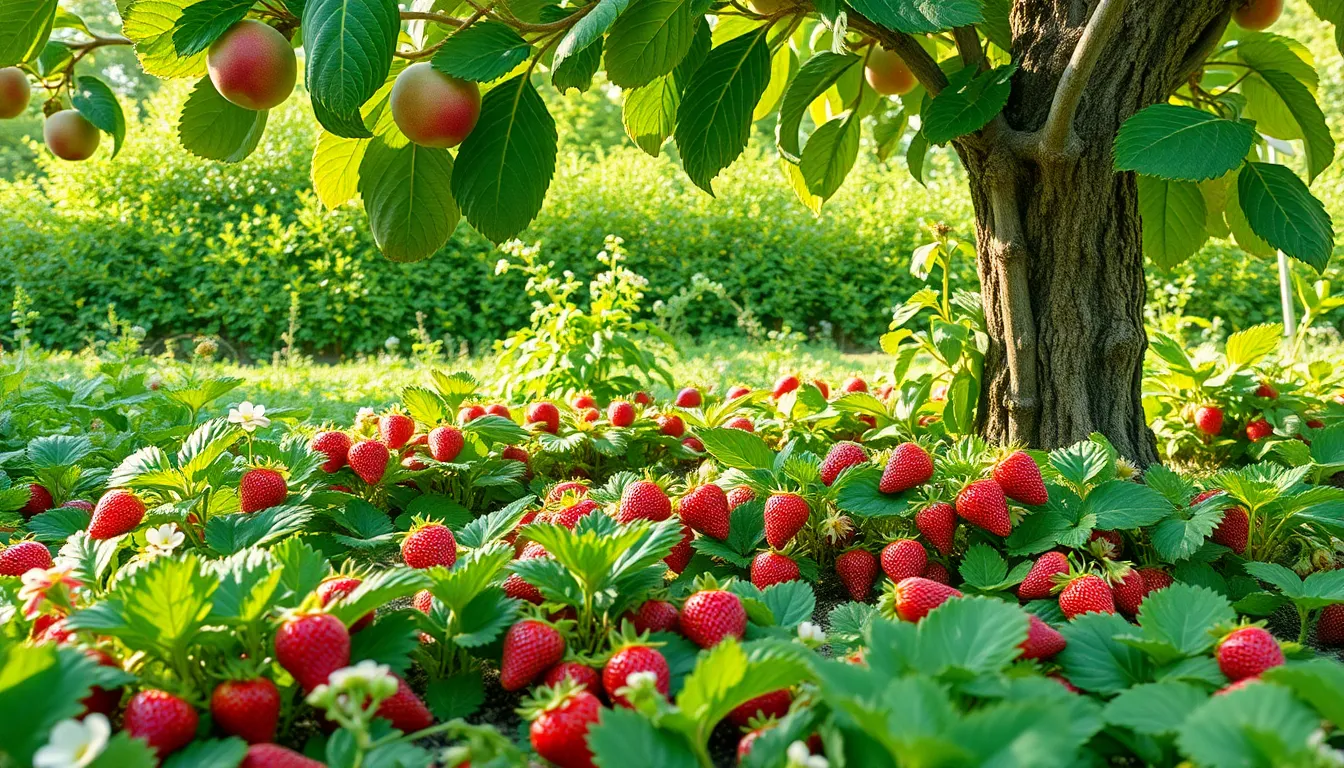
Beyond annual companions, we can establish permanent partnerships with fruit trees and perennial plants that’ll support our strawberry patch for years to come. These long-term companions create lasting benefits through complementary growing patterns and natural protection systems.
Apple Trees for Complementary Growing Seasons
Apple trees create an ideal partnership with strawberries through their perfectly timed growing seasons and beneficial microclimate effects. We find that apple trees provide partial shade during the hottest summer months, protecting our strawberry plants from intense sun that can stress the berries and reduce their sweetness.
Apple trees’ deep root systems work at different soil levels than strawberries, eliminating competition for nutrients and water. The trees’ canopy creates a microclimate that maintains consistent soil moisture and temperature, conditions that strawberries thrive in throughout their growing season.
Spring apple blossoms attract the same pollinators that benefit strawberry flowers, creating a pollinator highway that boosts fruit production for both crops. We can harvest strawberries in early summer while apple trees are still developing their fruit, maximizing our garden’s productivity without timing conflicts.
Rhubarb for Natural Pest Deterrence
Rhubarb serves as a powerful natural pest deterrent due to its unique chemical properties that repel many common strawberry pests. We’ve discovered that rhubarb’s natural compounds create a protective barrier around nearby strawberry plants, reducing the need for chemical pest control methods.
Rhubarb’s large leaves provide ground coverage that suppresses weeds while its deep taproot brings nutrients from lower soil layers to the surface. This perennial companion requires minimal maintenance once established, making it an excellent long-term investment for our strawberry garden.
The timing works perfectly since we can harvest rhubarb stalks in early spring before strawberry season peaks, giving us two crops from complementary plants. Rhubarb’s pest-repelling properties remain active throughout the growing season, providing continuous protection for our strawberry patch without any additional effort on our part.
Ground Cover Companions for Weed Suppression
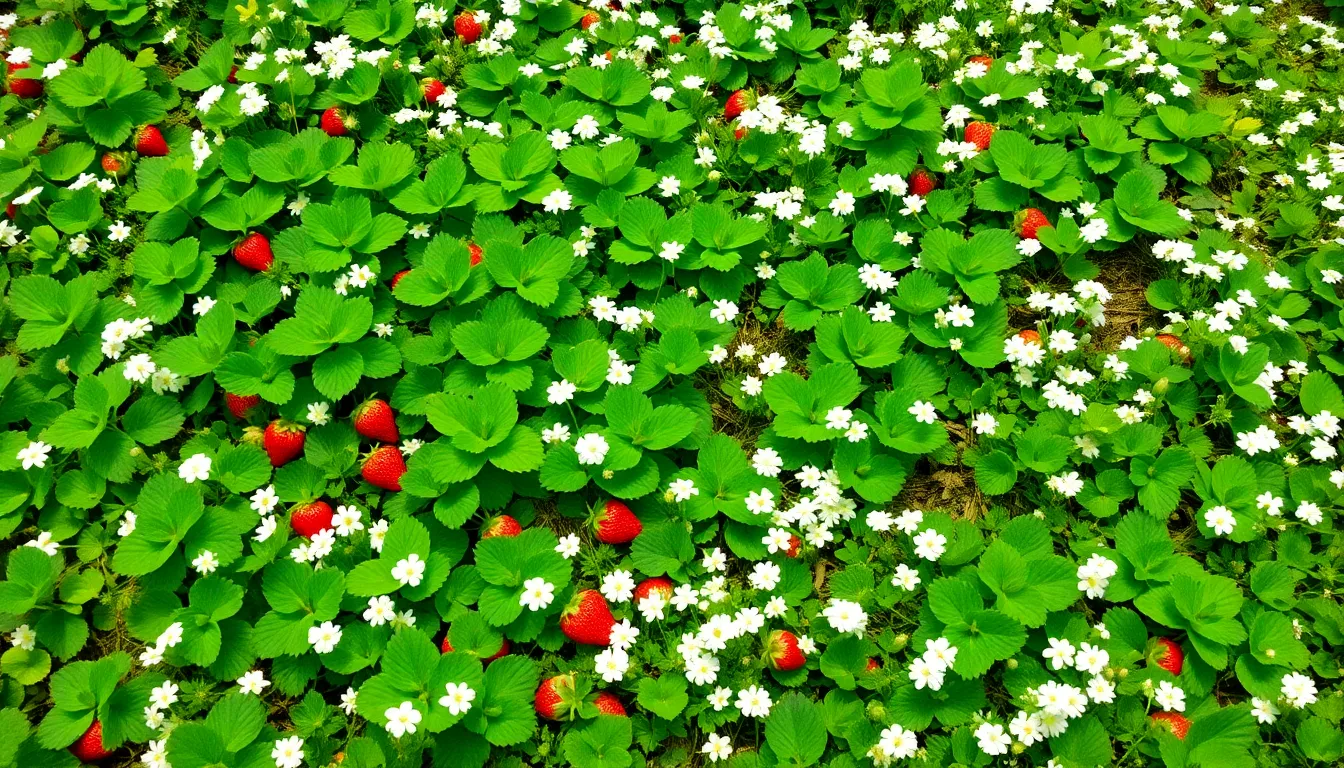
We’ve found that strategic ground cover plants create living carpets that naturally suppress weeds while supporting our strawberry plants. These companion plants offer multiple benefits beyond weed control.
White Clover for Soil Enrichment
White clover transforms our strawberry garden into a nitrogen-rich environment through its remarkable soil-building properties. This leguminous plant forms symbiotic relationships with soil bacteria, fixing atmospheric nitrogen and making it readily available to our strawberry plants without synthetic fertilizers.
Planting white clover in pathways around strawberry beds maximizes benefits while preventing aggressive competition. The fragrant white flowers attract pollinators that boost strawberry yields and beneficial predatory insects that naturally control garden pests. We recommend keeping clover away from direct planting areas since it can overwhelm strawberry plants if placed too close.
Beyond soil nutrition, clover acts as living mulch that competes directly with weeds for space and nutrients. Its dense growth pattern effectively suppresses unwanted vegetation while maintaining soil moisture levels that strawberries need for optimal growth.
Wild Strawberries for Natural Mulching
Wild strawberries provide exceptional natural mulching benefits that protect and nurture our cultivated strawberry plants. These native ground covers spread naturally around primary strawberry plants, creating protective soil coverage that retains moisture and blocks weed emergence.
Their shallow root systems complement rather than compete with cultivated strawberries, making them ideal companions for maintaining healthy soil conditions. Wild strawberries help establish better microenvironments by moderating soil temperature fluctuations and protecting the delicate root zones of our main strawberry plants.
This natural mulching effect proves especially valuable for maintaining consistent soil moisture, which strawberries require throughout their growing season. The ground coverage from wild strawberries eliminates the need for synthetic mulches while adding to the overall garden network’s biodiversity and resilience.
Plants to Avoid Near Your Strawberry Patch
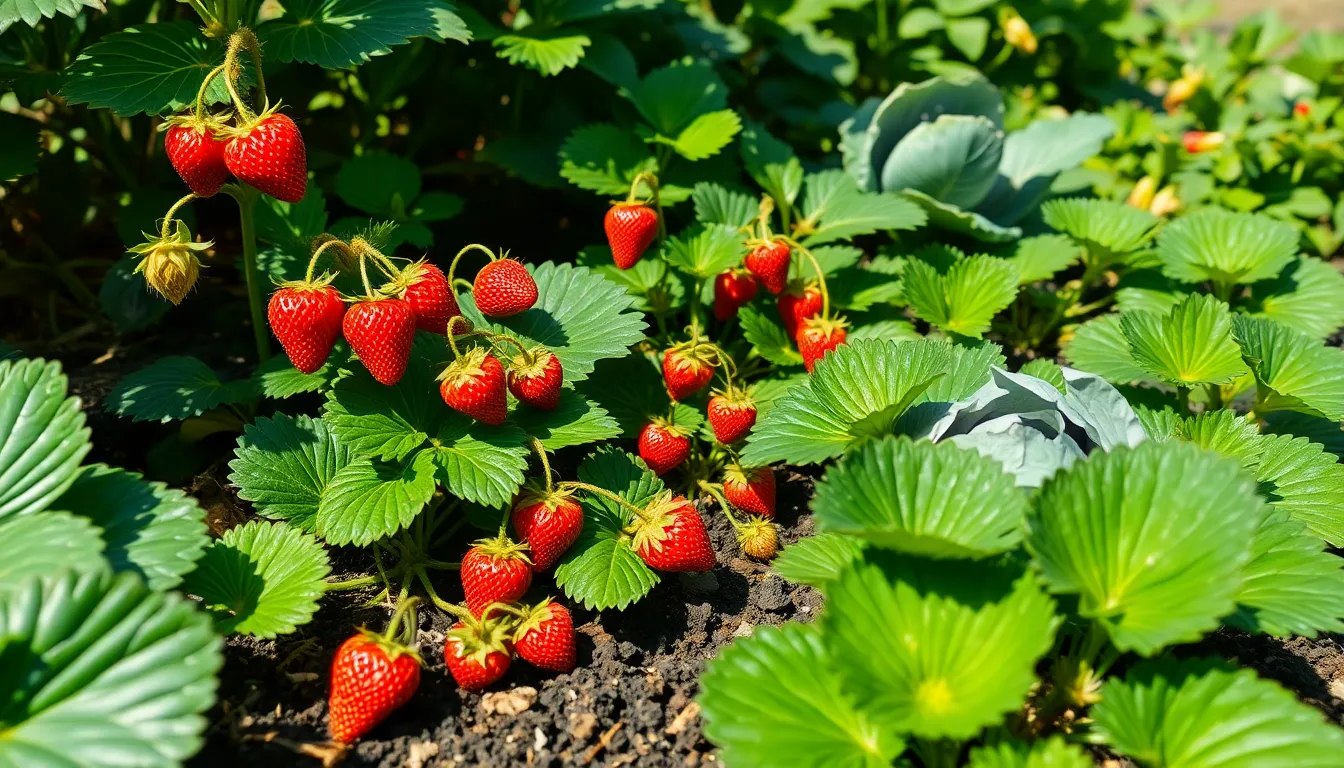
While companion planting can dramatically improve your strawberry harvest, certain plants can actually harm your berries’ growth and productivity. We’ll explore which plants to keep away from your strawberry patch to ensure optimal growing conditions.
Brassicas That Compete for Nutrients
Brassicas like cabbage, broccoli, and kale compete heavily with strawberries for essential nutrients in the soil. These plants create nutrient competition that can stunt strawberry growth and significantly reduce fruit yield. We’ve observed that brassicas have particularly aggressive root systems that absorb nutrients at a rapid rate, leaving strawberries with insufficient resources for healthy development.
Heavy nutrient demand from brassicas affects strawberry plants in several ways:
- Reduced berry size and quantity
- Weakened plant vigor
- Increased susceptibility to diseases
- Poor root development
Kale and cabbage family plants require substantial amounts of nitrogen, phosphorus, and potassium that strawberries also need for optimal fruit production. Brussels sprouts and cauliflower similarly drain soil nutrients, creating an environment where strawberries struggle to thrive.
Fennel and Other Allelopathic Plants
Fennel releases allelopathic chemicals into the soil that actively inhibit strawberry growth and development. These natural compounds act as growth suppressors, reducing both plant health and fruit quality in nearby strawberry plants. We recommend keeping fennel at least 6 feet away from any strawberry plantings to prevent chemical interference.
Allelopathic effects from fennel include:
- Suppressed root development
- Reduced flowering and fruit set
- Weakened plant immune systems
- Stunted overall growth
Walnut trees also produce allelopathic compounds through their roots and decomposing leaves, creating hostile growing conditions for strawberries. Black walnut trees are particularly problematic, as their juglone production can persist in soil for years after tree removal. Eucalyptus plants similarly release growth inhibiting chemicals that we’ve found to be detrimental to strawberry health and productivity.
Seasonal Planting Schedule for Strawberry Companions
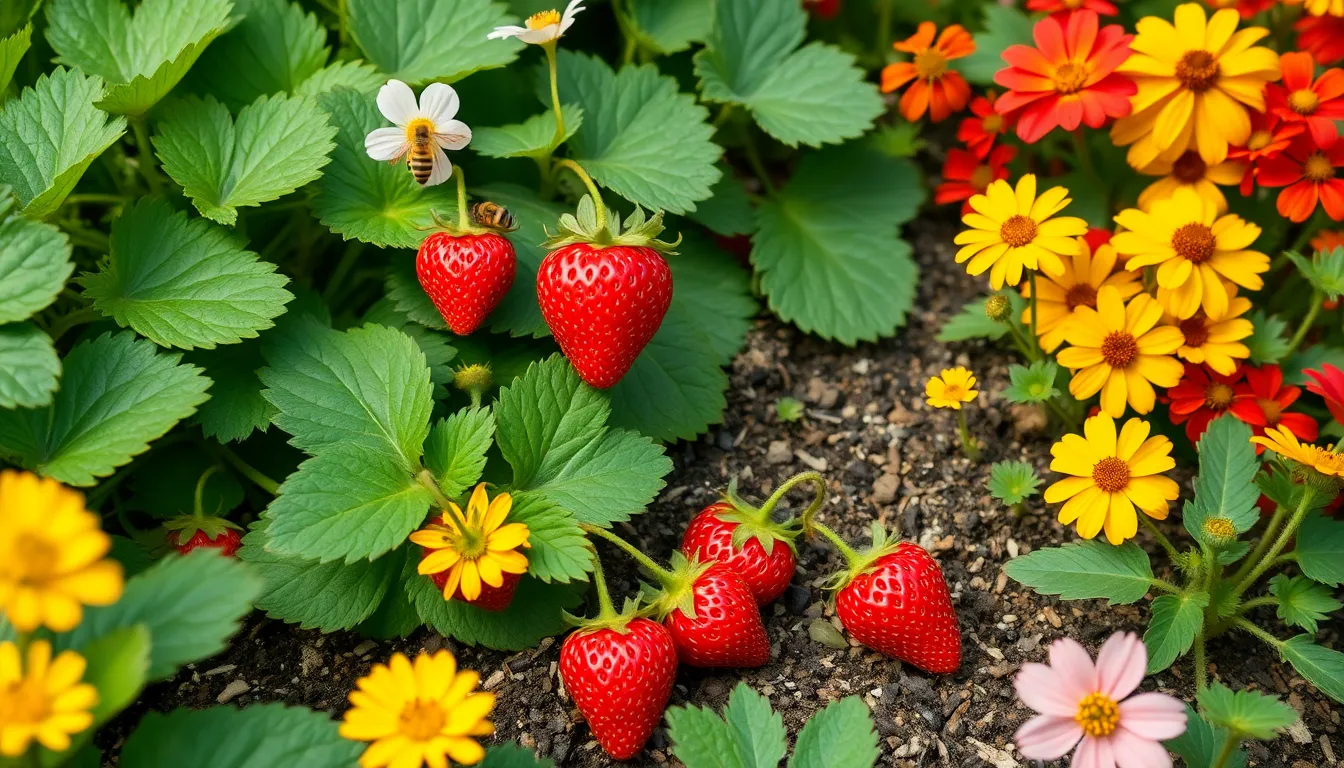
Timing companion plantings correctly maximizes the benefits we receive from our strawberry garden partnerships. Strategic seasonal planning ensures our companion plants provide optimal support throughout the entire growing cycle.
Spring Companion Planting Timeline
Early spring presents our best opportunity to establish pollinator attracting companions like nasturtiums and calendula alongside our strawberry plants. These flowering companions bloom simultaneously with strawberries, creating a buzz of bee activity that enhances pollination and improves fruit quality significantly.
Nitrogen fixing beans should be planted in early to mid spring to maximize their soil enrichment benefits throughout the growing season. These legumes convert atmospheric nitrogen into forms our strawberry plants can readily absorb, supporting robust growth without synthetic fertilizers.
We recommend starting nasturtiums from seed approximately 2-3 weeks before the last frost date in our region. Calendula can be direct seeded even earlier since it tolerates light frosts better than most flowering companions.
Spring planted herbs like basil and thyme establish strong root systems that provide pest deterrent benefits all season long. Basil should wait until soil temperatures reach 60°F consistently, while thyme can be planted as soon as the ground becomes workable.
Summer and Fall Companion Management
Summer maintenance focuses on keeping our flowering companions like calendula and nasturtiums blooming continuously to attract beneficial insects and control pest populations. Regular deadheading encourages prolonged flowering and maintains the protective benefits these plants provide.
Cover crops and additional nitrogen fixing plants can be established in summer and fall to replenish soil nutrients for the following strawberry season. These plantings prepare our garden beds while continuing to support current strawberry production.
We monitor trap crop effectiveness during summer months, noting which companions successfully divert pests from our strawberry plants. Nasturtiums often require replacement planting every 6-8 weeks to maintain their trap crop function effectively.
Fall companion management includes allowing beneficial plants like beans to complete their lifecycle, returning organic matter to the soil. This natural composting process enriches our strawberry beds while maintaining the network balance we’ve established throughout the growing season.
Conclusion
We’ve explored how companion planting can transform your strawberry garden into a thriving network where every plant works together for mutual benefit. From pest-repelling herbs like basil and thyme to nitrogen-fixing beans and pollinator-attracting flowers our carefully chosen companions create natural protection while boosting yields.
The key to success lies in understanding both beneficial partnerships and harmful combinations. While marigolds and nasturtiums support strawberry growth avoiding competitive plants like brassicas ensures our berries get the nutrients they need to flourish.
By following our seasonal planting guide and selecting the right mix of herbs vegetables and flowering plants you’ll create a self-sustaining garden that produces abundant strawberries year after year. Start small with a few proven companions and watch your strawberry patch transform into a productive paradise.
Frequently Asked Questions
What is companion planting for strawberries?
Companion planting for strawberries involves growing specific plants alongside strawberry plants to create beneficial partnerships. These companion plants help repel pests, improve soil health, enhance pollination, and boost overall berry production. The practice transforms your strawberry garden into a network where plants support each other’s growth and protection naturally.
Which herbs make the best companions for strawberries?
Basil, thyme, and chives are excellent herb companions for strawberries. Basil repels aphids and spider mites while attracting pollinators. Thyme suppresses weeds and enhances strawberry flavor. Chives effectively control aphid populations. These herbs create a protective barrier around strawberry plants and reduce the need for chemical pest control methods.
Can vegetables be grown with strawberries?
Yes, several vegetables make excellent strawberry companions. Bush beans enrich soil through nitrogen fixation, lettuce provides living mulch while optimizing space, and spinach acts as early-season ground cover. These vegetables help maintain soil moisture, suppress weeds, and provide essential nutrients without competing aggressively with strawberry plants.
What flowering plants attract beneficial insects to strawberry gardens?
Nasturtiums, marigolds, and borage are ideal flowering companions. Nasturtiums act as trap crops diverting pests while attracting pollinators. Marigolds control nematodes and attract beneficial insects that prey on strawberry pests. Borage excellently attracts bees, enhancing pollination and fruit development while offering culinary benefits.
Which plants should I avoid near strawberries?
Avoid planting brassicas (cabbage, broccoli), fennel, walnut trees, and eucalyptus near strawberries. Brassicas compete heavily for nutrients and can stunt growth. Fennel releases chemicals that inhibit strawberry development. Walnut and eucalyptus trees produce growth-suppressing compounds that create hostile conditions for strawberry plants.
When should I plant strawberry companions?
Plant companion plants strategically throughout the season. In early to mid-spring, establish pollinator-attracting flowers like nasturtiums and nitrogen-fixing beans. Summer focuses on maintaining blooming companions to attract beneficial insects. Fall allows plants like beans to complete their lifecycle, enriching soil for the following season.
How do ground cover companions help strawberries?
Ground cover companions like white clover and wild strawberries create living carpets that naturally suppress weeds. White clover fixes atmospheric nitrogen and attracts pollinators, while wild strawberries provide natural mulching benefits and maintain soil moisture. These plants enhance overall garden ecosystem health and resilience.

